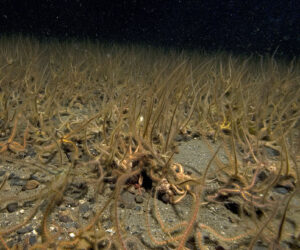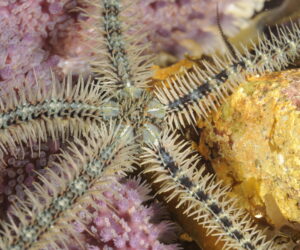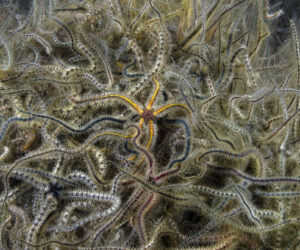The common brittlestar is an echinoderm, closely related to starfish. It is found in shallow marine waters and has a disk-like spiny body with five long thin flexible arms (often spiny), which it uses to crawl across the sea floor. They vary in colour from dull brown to purple, red, orange and yellow.
Behaviour
Common brittlestars are epifaunal and live in extremely large groups offshore, (as many as 2000 individuals recorded), known as ‘brittlestar beds’. Within the intertidal zone, they are most often found individually.
Brittlestars typically hide under rocks or in crevices during the day and emerge at night to feed. They feed by extending one or more arms into the water or over the mud, the other arms serving as anchors.
Their diet includes small organisms and detritus which they can either filter feed out of the water column or use their mouths (which have five toothed jaws) to actively catch their prey.
The arms readily break off, but soon regrow. As long as the central disk is intact, the brittlestar can lose any or all of its arms and grow them back.
Size
- Diameter of disk: 2 to 20 mm
- Average lifespan: up to 5 years
Status
Common
Distribution
Common brittlestars are found around the coast of the British Isles in rockpools on the lower shore and offshore to depths of 85m. They are less abundant on the east coast of England and Scotland.
When to see
January to December
Facts
- Brittlestars have no anus. Waste materials are eliminated through the mouth.
- The Latin name ophiurusis from Ancient Greek (óphis) ‘serpent’, and (ourá) ‘tail’, refers to the serpent-like arms of the brittle star.



